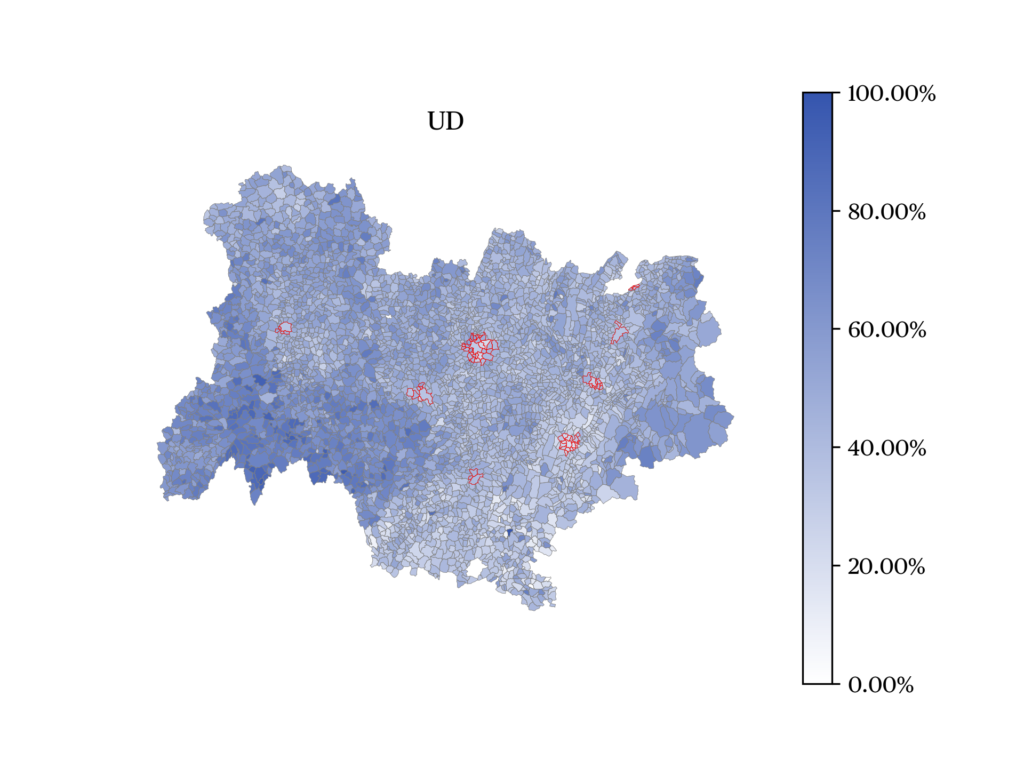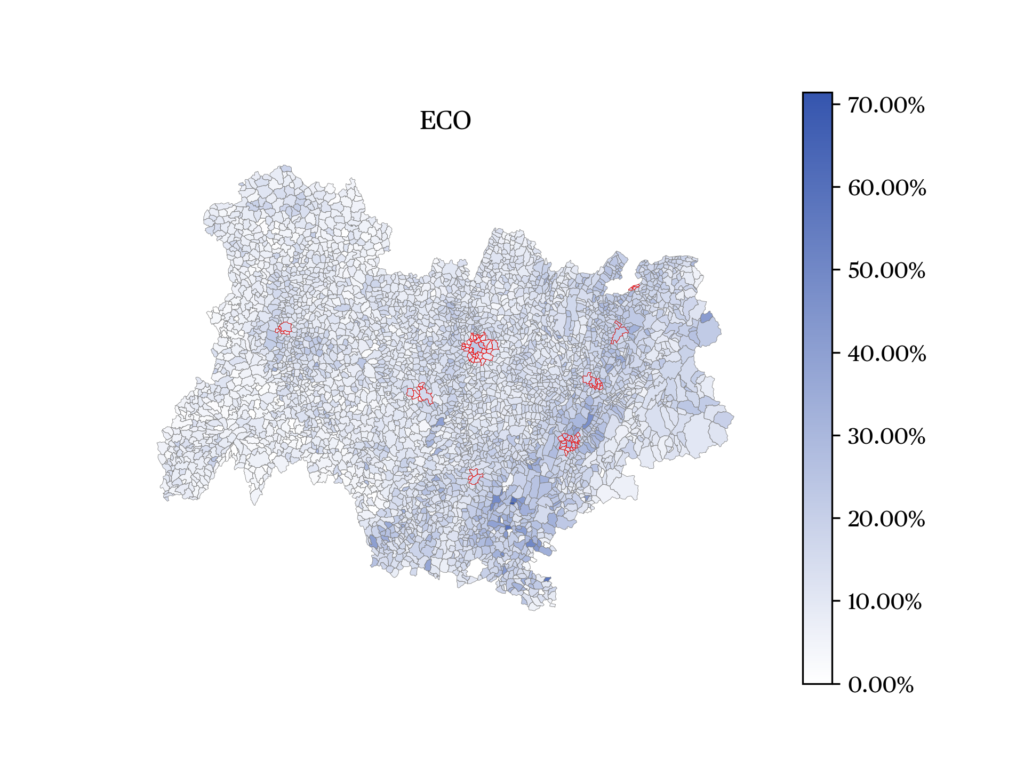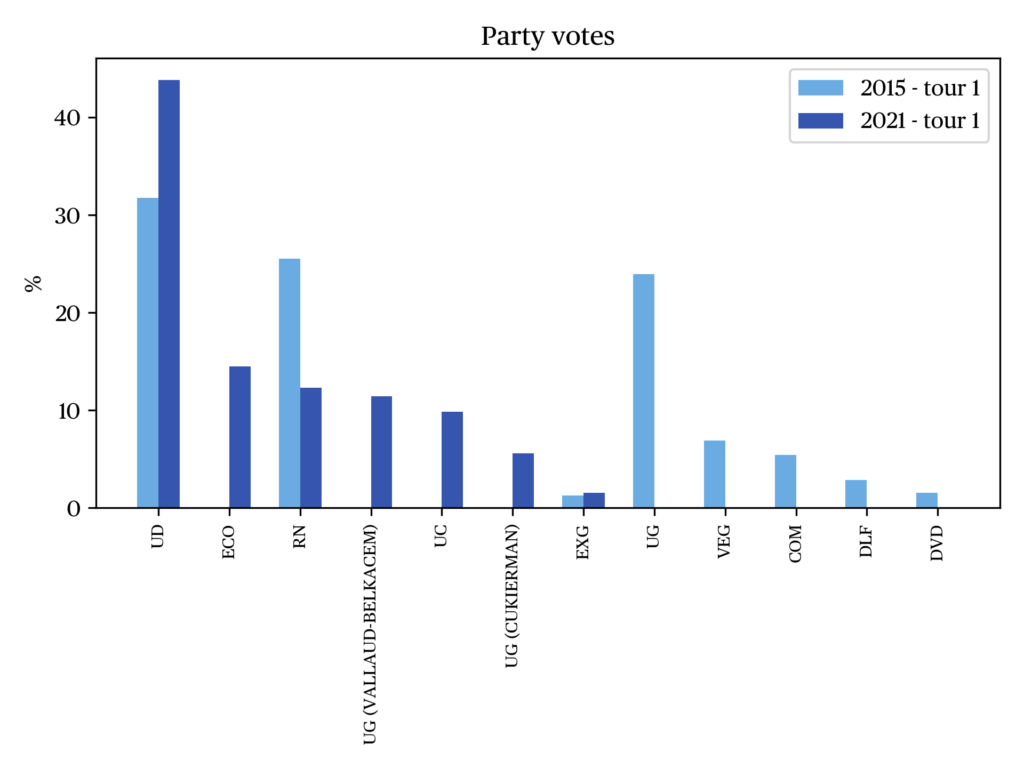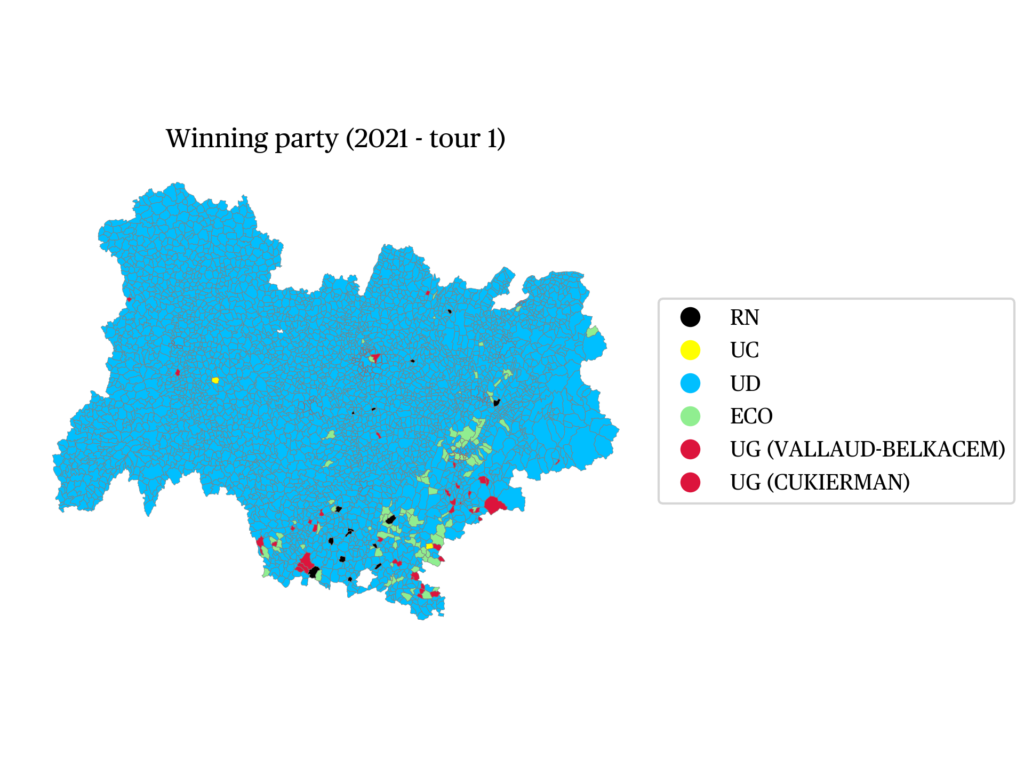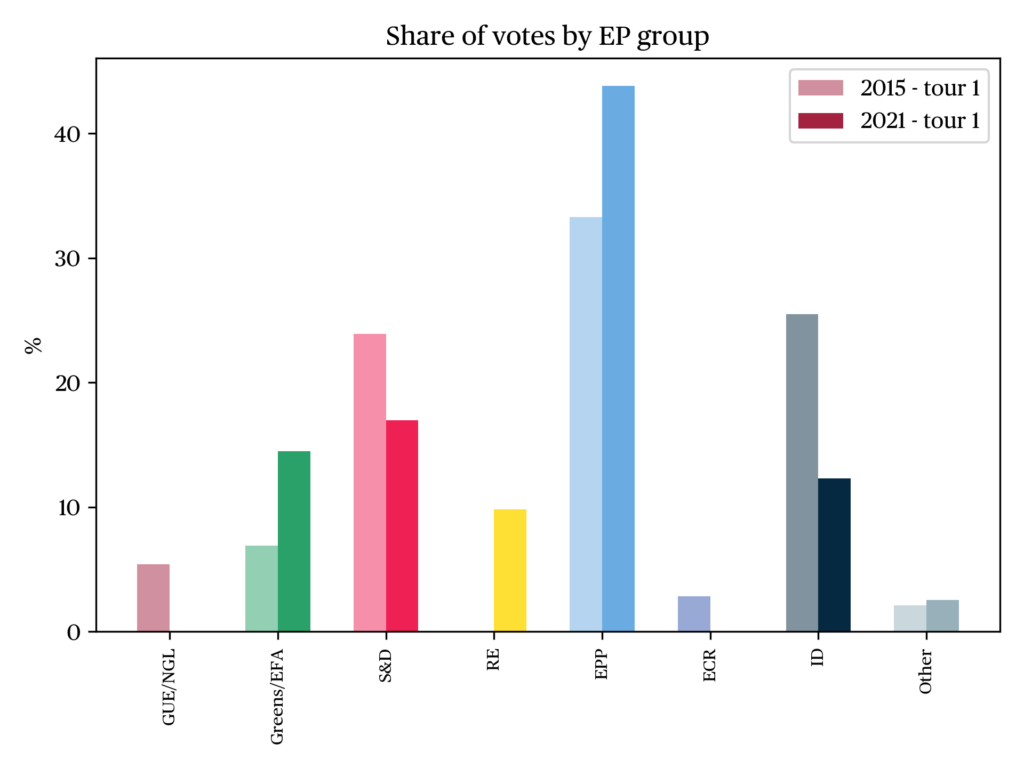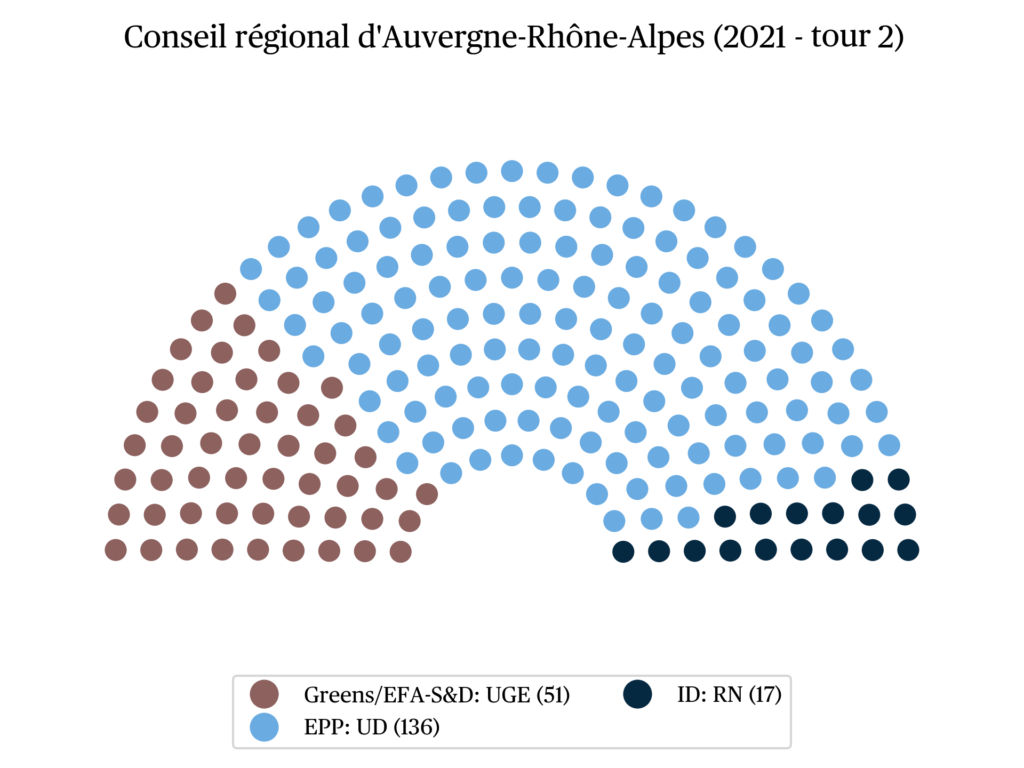Regional election in Auvergne-Rhône-Alpes, 20-27 june 2021
Florent Gougou
Lecturer at the PACTE research center (Sciences Po Grenoble)Issue
Issue #2Auteurs
Florent Gougou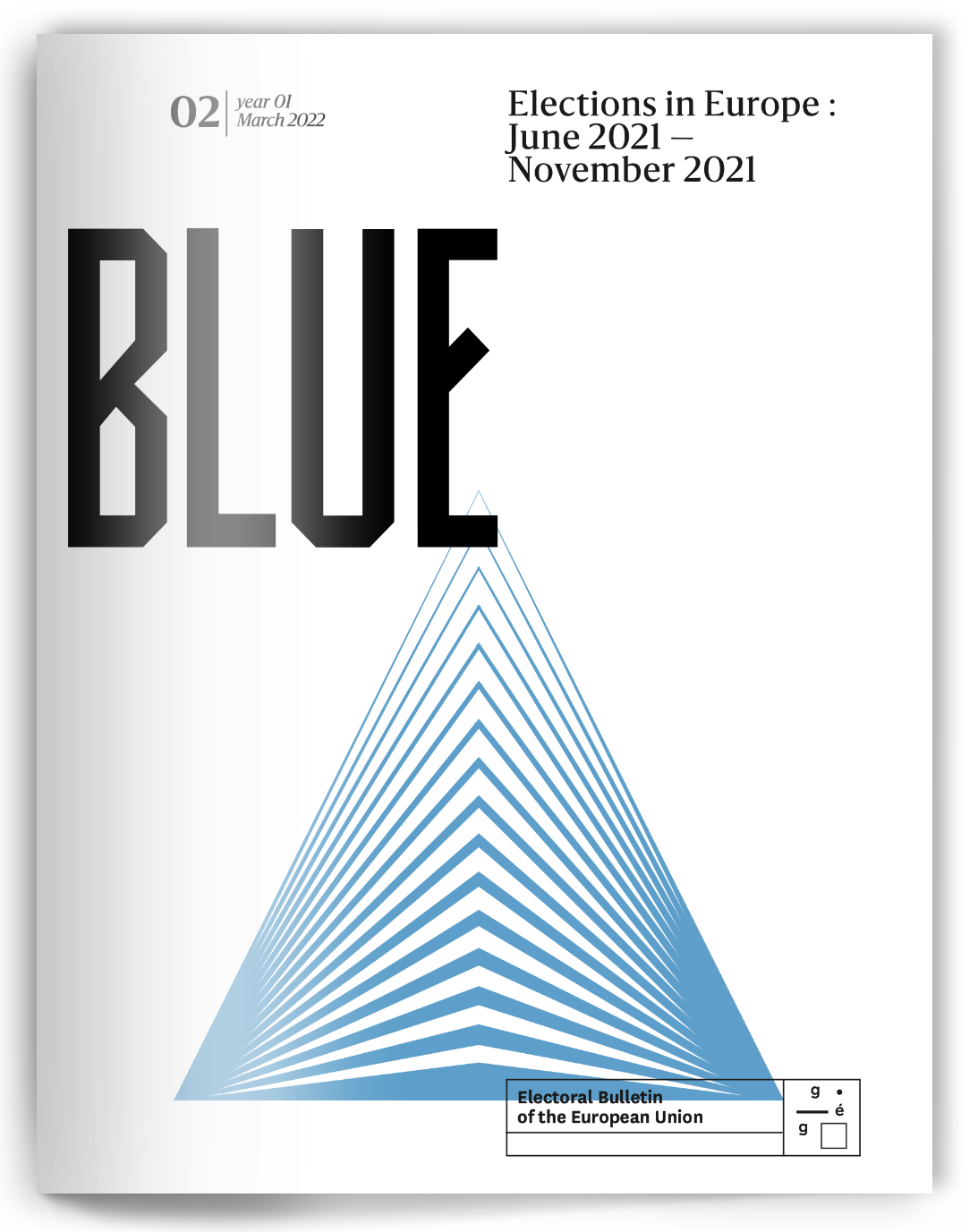
21x29,7cm - 167 pages Issue 2, March 2021 24,00€
Elections in Europe : June 2021 – November 2021
The June 2021 regional election in Auvergne-Rhône-Alpes (Aura) concerned the renewal of the 204 seats in the assembly of the new region.
1
It corresponded to the regular end of the mandate of the regional councillors of all the regions of France,
2
but also to the end of the mandate of all departmental councillors.
3
Thus, for the first time since 2004, the regional elections were held on the same day as another election.
4
This element of the electoral calendar was not insignificant, given the potential knock-on effects of one election on the other.
This timing had been a major issue in the run-up to the elections, with the opposition accusing the government of trying to avoid a setback by hiding behind the context of the Covid-19 pandemic. In fact, the elections had been postponed to June in the hope of slowing down the contagion, whereas they had initially been scheduled for March. On the other hand, nothing had changed with regard to the re-synchronisation of the regional and departmental elections: it had been planned by the socialist government in 2015 and was therefore not the result of a strategic calculation by the current government.
However, the re-synchronisation could have had two consequences on the electoral balance of power: (1) counteracting the trend of declining turnout by minimising the effects of electoral fatigue; (2) lessening the impact of intermediate elections on national power dynamics by limiting the number of moments that could give rise to a sanction vote against the government. This second effect was not negligible insofar as the two previous presidential mandates had been punctuated by a succession of heavy local electoral defeats sanctioning very unpopular executives.
5
The 2021 elections allowed researchers to reopen the question of the link between local elections: their decoupling had initially been decided by center-right parties under the Sarkozy presidency to limit the contagion effects of a vote-sanction in the regional elections at cantonal (and departmental) level, the latter being deemed less subject to national contagion.
In Aura, more than 5 million voters were simultaneously called to elect their regional councillors and their departmental councillors in the 13 departments making up the greater region,
6
according to two different voting methods. For the regional elections, a mixed two-round voting system
7
was used, combining proportional representation for 75% of the seats and a majority bonus of 25% of the seats for the list that came out on top in the decisive round. For the departmental elections, a first-past-the-post system was used, with candidates forming gender-balanced tickets composed of a main candidate and its deputy.
8
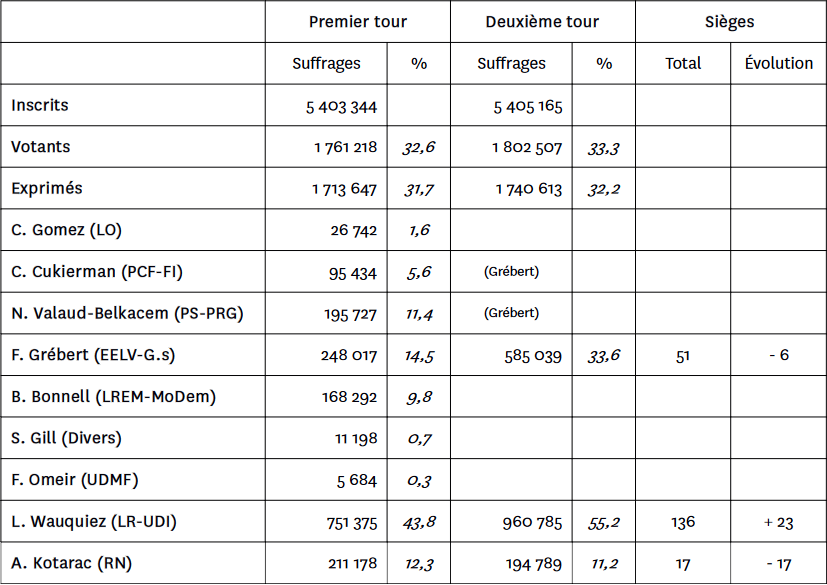
NB. Results are in percentage of registered voters and votes cast, in percentage of votes cast for list results.
The national and regional context
As elsewhere in Europe at the same time, these elections were marked by the Covid-19 pandemic. Two dimensions were particularly affected by the epidemic context: the themes considered as priorities by the voters on the one hand, and the material conditions of the campaign on the other.
As regards priority themes, the survey carried out by Ifop at the beginning of June 2021
9
revealed that 77% of those questioned considered that the theme of health would be a priority in Aura in the coming months, with 63% considering the theme of the fight against the Covid-19 epidemic to be the same. Other issues at the top of the agenda included the fight against crime, which was considered a top priority by 71% of respondents, education by 68% and the fight against terrorism by 66%. These proportions were similar in the other regions, indicating that the agenda was dominated by health issues and major sovereignty issues rather than by themes related to regional competences. Rather than social and societal concerns, the fight against precariousness was considered a top priority in Aura by 57% of respondents, and environmental protection by 52%.
As for the material conditions of the campaign, the restrictions linked to the organisation of very large gatherings and the fears of the population largely constrained the traditional means of communication of the candidates, notably public meetings. These elements were very favourable to the outgoing regional president, Laurent Wauquiez (LR, EPP), who had made security his main campaign theme and could take advantage of the notoriety linked to his position. At the end of his first mandate, the most favourable moment in his personal electoral cycle, and belonging to a party in opposition at national level, nothing seemed to threaten him.
The electoral offer
As in the 2015 regional elections, 9 lists were present in the first round, a total almost identical to the national average (8.8 lists per region). The stability of the number of lists resulted from a form of continuity in the structuring of the regional electoral offer, despite the reconfigurations of the national political landscape at work since the 2017 presidential and legislative elections, in particular the collapse of the two former orderly structures, the PS and LR, and the emergence of a new government party in a central position around Emmanuel Macron.
On the left, we found the same 4 lists as in 2015: a list for Lutte Ouvrière (LO) led by Chantal Gomez, a list for the Communist Party (PCF) led by Cécile Cukierman, a list for the Socialist Party (PS) led by Najat Vallaud-Belkacem and a list for Europe Écologie Les Verts (EELV) led by Fabienne Grébert. The only change came from the alliance chosen by Jean-Luc Mélenchon’s supporters: the Left Party (PG) was allied with EELV in 2015, while France insoumise (FI) joined the PCF in 2021.
10
Part of the preparation of the campaign had been driven by the project of a single left-wing list, but the union had stalled on the issue of the composition of the list, EELV wishing to base itself on the results of the 2019 European elections, the PS on the 2015 regional elections.
11
In the centre was the list of the presidential majority led by Bruno Bonnell, which benefited from the investiture of all the governmental forces, starting with La République en Marche (LREM) and the Democratic Movement (MoDem). The MoDem thus confirmed its break of alliance with the outgoing President Laurent Wauquiez, which occurred in March 2019. This list of the presidential majority covered part of the space that had been occupied in 2015 by the diverse right-wing list led by Éric Lafond, a former MoDem member.
In the end, the main variations came from the right of the partisan spectrum, where the offer was reduced to the list of the outgoing majority of Laurent Wauquiez and the list of the National Rally (RN) led by Andréa Kotarac, a former elected member of the FI, while two lists of the sovereignist right were present in 2015. Two unclassifiable lists, led by Shella Gill (Union essentielle, close to the Gilets Jaunes) and Farid Omeir (Union des Démocrates Musulmans Français), completed the 2021 cast.
The results of the first round
As in all the other regions, the results of the first round were marked by a collapse in turnout: with only 32.6% of voters, the rate of participation fell by more than 16 points compared to 2015 (Figure c), setting a record low for regional elections.
The abrupt nature of this drop in participation has led observers to insist on cyclical factors, and in particular on the weight of the epidemic context. However, this explanatory model seems insufficient once the trends in turnout are put into historical perspective. Since the beginning of the 1980s, France has experienced a long-term trend of declining turnout in all elections, with the exception of the presidential election. The succession of turnout rates in the first round of regional elections bears witness to this: 77.9% in 1986; 68.6% in 1992; 57.7% in 1998; 60.8% in 2004; 46.3% in 2010; 49.9% in 2015. Three short-term elements may have temporarily slowed down this strong trend: a very unpopular government (2004, 2015), the fact that it was the first intermediate election in the national electoral cycle (2004), a dramatic political situation (2015, after the attacks in Paris). None of these factors were present in the 2021 regional elections. In contrast, the previous regionals in 2015 combined two of these factors, so that the return of the long-term dynamic to declining turnout had a particularly impressive boomerang effect.
This fall in participation does not affect all the departments in the region in the same way: it reaches its maximum in the Loire (-19.2) and its minimum in the Cantal (-8.6).
12
Behind these different trends between departments, an opposition emerges between rural areas, which are mainly made up of older people with a strong sense of civic duty, and urban areas, which are mainly made up of younger generations, more individualised and more detached from the institutions of social life. This opposition is reflected in the absolute levels of participation: 41.9% of voters in the Cantal and 40.5% in the Haute-Loire, against 30% in the Loire and 30.5% in the Rhône.
In this context, the list of the outgoing majority came out on top in the first round. With 43.8% of the votes cast (+12.1 points compared to 2015) and a lead of more than 29 points over the Grébert list, which came second, Laurent Wauquiez’s list achieved an exceptional performance: in the history of regional elections in France, the largest gap between the first two lists was 22 points for Martin Malvy’s PS list in the Midi-Pyrénées in 2004.
The geography of the results of the LR-UDI list reveals non-negligible differences between the former Auvergne in the west and the former Rhône-Alpes in the east (graph 1). In the western part of the new region, the Wauquiez list recorded its best departmental results (Haute-Loire 67.7%; Cantal 66.1%) and its strongest increases (Cantal +21.8; Allier +21.1; Puy-de-Dôme +17), taking advantage of the personal establishment of the President of the region.
13
Conversely, in the eastern part of the new region, it achieved its lowest scores (Isère 34.9%; Drôme 38.6%) and its lowest increases (Isère +8.7; Haute-Savoie +9.3).
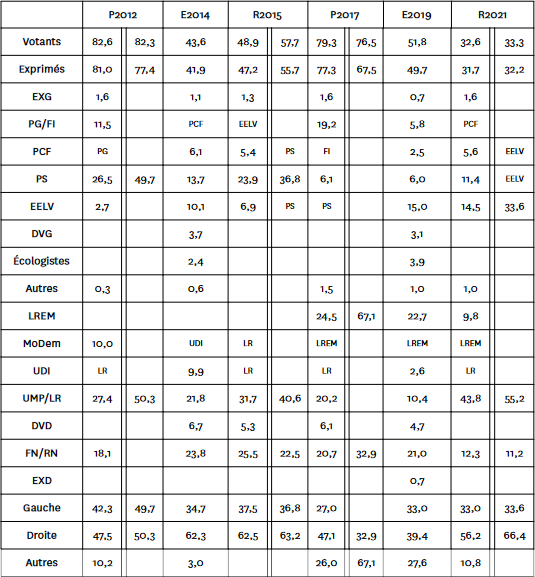
Compared to the results in the other French regions, this dynamic of the Wauquiez list is part of a more general movement that favours all the outgoing right-wing presidents: in the 7 regions concerned, the lists of the outgoing right-wing majorities come out on top with results above 30% and strong increases over 2015, benefiting from the support of part of the electorate of the presidential majority, the weaker presence of the various right-wing lists and a very clear decline of the RN. These movements are particularly clear in relation to the 2019 European elections (Figure b, top). On the radical right, the Kotarac list lost half of its surface area in the 2015 regions (from 25.5% to 12.3%), and almost the same as the RN list in 2019 (21.2%), even though it managed to exceed the 10% mark and reach the second round. On the presidential majority side, the Bonnell list fails to qualify for the second round (9.8%), far from the level of the LREM-UDI list in 2019 (22.7%).
In this context of weak opposition, the Grébert list (EELV) is the only one to have some grounds for satisfaction. With 14.5% of the votes cast (+7.6 points compared to 2015), it leads the left, ahead of the Vallaud-Belkacem list (11.4%, down 12.5 points on the PS list of 2015) and the Cukierman list (5.6%, +0.2 on 2015). This strong environmentalist dynamic is in line with the results of the 2019 European elections, where the Jadot list (EELV) obtained 15% in Aura. It is also found elsewhere in France, in equivalent configurations: everywhere where the right is outgoing, the left-wing primaries in the first round turn in favour of EELV (Ile-de-France, Pays-de-la-Loire). The Greens’ areas of strength are essentially in the former Rhône-Alpes region (Figure b, bottom), with scores of 18.3% in Haute-Savoie and 17.7% in Isère, compared with 7% in Cantal and 8.1% in Allier.
The results of the second round
The campaign between the two rounds was brief and essentially punctuated by the merger between the three left-wing lists behind Françoise Grébert. Eliminated in the first round, Bruno Bonnell refused to give voting instructions on behalf of the presidential majority. In a triangular race against the left-wing union list and the RN, the victory of Laurent Wauquiez seemed to be a foregone conclusion.
As a result, despite calls for a citizen’s awakening in all regions, turnout did not improve: 33.3% of voters, 24 points lower than in 2015. In France, two configurations are conducive to an increase in turnout between the two rounds of an election: (1) the fear of a victory for the RN; (2) a competition that looks close. Neither of these factors was present in the 2021 Aura region. In only one region was there a fear of the RN: it was in Provence-Alpes-Côte-d’Azur and participation rose by 3 points between the two rounds.
Laurent Wauquiez’s victory was very clear with 55.2% of the vote (+14.6 compared to the second round in 2015). Compared to the first round (+11.4 points), he benefited from the elimination of the Bonnell list but also from a further decline of the RN, with the Kotarac list falling from 12.3% to 11.2%. This victory translates into a large majority for Laurent Wauquiez in the new regional council: 136 seats, 23 more than in 2015. Most of this progress was achieved at the expense of the RN, which suffered a drain on its pool of local elected representatives: it now has only 17 seats, half as many as in 2015. For Marine Le Pen’s party, this is a setback in its strategy of local establishment.
The locomotive Wauquiez also pulled the right in the departmental elections. On the eve of the election, the LR-UDI right held 9 of the 11 departmental presidencies in the region; at the end of the election, it managed to topple the Ardèche and the Puy-de-Dôme, so that it now controls all the departmental executives. It is in Auvergne-Rhône-Alpes that the impact of the regional elections on the departmental elections was most visible, confirming the extent of the Wauquiez dynamic.
Theoretical perspectives
For three decades, the second-order election model (Reif, Schmitt, 1980; Parodi, 2004) has been the main model for analysing regional elections in France and in Europe. This model suggests that regional election results are characterised by three dynamics compared to the national benchmark elections: (1) a decline in turnout; (2) a decline of major parties in favour of peripheral parties; (3) a decline of parties in government at the national level. This model does not take into account the main dynamics of the 2021 regional elections in Aura, and in particular the growth of the LR list of the outgoing President Laurent Wauquiez.
From this point of view, the model of candidate-centred politics seems to have a greater explanatory capacity. This model developed in the United States is based on a combination of five main elements: (1) a decline in the influence of partisan proximity on voting; (2) a decline in turnout; (3) an increase in split-ticket voting; (4) a high level of incumbent re-election; (5) a high level of divided government. None of the empirical evidence provided in this article challenges this model. However, systematic research is still needed to assess its explanatory capacity for the major recent electoral developments in France.
Literature
Escalona Fabien, Labouret Simon, Vieira Mathieu (2013). France: Regional Elections as ‘Third-Order’ Elections? In Dandoy R., Schakel A. (dir.), Regional and National Elections in Western Europe, Palgrave MacMillan, pp. 88-105
Gougou Florent, Persico Simon (2017). A New Party System in the Making? The 2017 French Presidential Election. French Politics, 15 (3), pp. 303-321
Martin Pierre (2004), Des cantonales à l’image des régionales. Revue française de science politique, 54 (4), pp. 681-695
Parodi Jean-Luc (2004). Les élections ‘intermédiaires’ du printemps 2004 : entre structure et événement. Revue française de science politique, 54 (4), pp. 533-543
Schakel Arjan H., Jeffery Charlie (2013), Are Regional Elections really ‘Second-Order’ Elections? Regional Studies, 47 (3), pp. 323-341
Wattenberg Martin (1991), The Rise of Candidate-Centered Politics: Presidential Elections of the 1980s, Harvard University Press.
Acknowledgements
I sincerely thank the anonymous reviewer and my colleague Pierre Martin for their comments and suggestions on the first draft of this text. They allowed me to clarify certain sections and to strengthen the theoretical argumentation. The remaining interpretations and errors in this paper remain my sole responsibility.
Notes
- A redrawing of the regions took place in 2014 as part of a third phase of French decentralization. Implemented by President François Hollande (PS), the new territorial organization of the Republic reduced the number of regions from 22 to 13. Auvergne-Rhône-Alpes was formed through the merger of the former regions Auvergne and Rhône-Alpes.
- The previous regional elections were held on December 6 and 13, 2015, for 5 1/2 year terms.
- The previous departmental elections were held on March 22 and 29, 2015, for 6-year terms. This was the first time “departmental” elections were organized (these had in the past been called “cantonal”).
- The regional elections were organized simultaneously with the legislative elections in 1986, then with the cantonal elections from 1992 to 2004.
- During the Sarkozy presidency (2007-2012), the governing right-wing UMP-UDI lost in the 2008 municipal, 2010 regional and 2011 cantonal elections. During the presidency of François Hollande (2012-2017), the PS lost in the 2014 municipal elections, the March 2015 departmental elections and the December 2015 regional elections.
- The inhabitants of the communes of the Lyon metropolis were only concerned by the regional elections. On its territory, the metropolis of Lyon has exercised the powers of a department since the adoption of the Maptam law and the metropolitan elections in Lyon were held simultaneously with the municipal elections in 2020.
- In the first round, a list wins the election if it obtains more than 50% of the votes cast; if no list reaches this threshold, a second round is organized where obtaining a plurality is sufficient to win. In the event of a second round, the lists that have reached 10% of the votes cast in the first round may decide whether or not to advance to the second round. List mergers are possible between the two rounds for all lists having reached 5% in the first round, but the merger is only possible if at least one of the lists involved has exceeded 10% in the first round.
- In the first round, a ticket wins the election if it obtains more than 50% of the votes cast and 25% of the registered voters; if no ticket reaches these thresholds, a second round is organized where a plurality is sufficient to win. In the event of a second round, the two tickets that came out on top in the first round and all pairs that have reached 12.5% of the registered voters can continue to run.
- This survey was self-administered online from May 31 to June 4 to a sample of 992 people registered on the electoral rolls. This sample is itself drawn from a sample of 1100 people representative of the population over 18 years old living in the Aura region (according to the quota method on age, gender and occupation of the person interviewed).
- However, the entire PCF federation of the Allier refused to support the Cukierman list and rallied to the Vallaud-Belkacem list on the basis of a local PS-PCF agreement in the departmental elections and hostility to the FI.
- The situation was very different in the departmental elections, where the main left-wing parties had managed to run on common tickets in more than half of the departments (Ain, Allier, Drôme, Isère, Loire, Puy-de-Dôme, Rhône).
- This rural/urban opposition between departments is also found within departments. In Isère, for example, turnout fell by 18.9 points in the canton of Bourgoin-Jallieu and 17.7 points in the canton of Echirolles, compared to “only” 9.5 points in the canton of Matheysine-Trièves.
- Laurent Wauquiez was a member of the National Assembly for the Haute-Loire and mayor of Puy-en-Velay, the department’s capital, before becoming president of the region.
citer l'article
Florent Gougou, Regional election in Auvergne-Rhône-Alpes, 20-27 june 2021, Mar 2022, 56-61.
à lire dans cette issue
voir toute la revue






